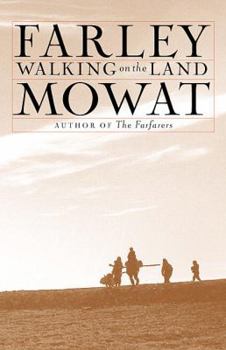Walking on the Land
Select Format
Select Condition 
Book Overview
Using one of his own trips through the Eastern Arctic as a starting point, Farley Mowat interweaves the stories of the Barren Ground Inuit with stunning, lyrical descriptions of the Northern... This description may be from another edition of this product.
Format:Paperback
Language:English
ISBN:1586420240
ISBN13:9781586420246
Release Date:May 2001
Publisher:Steerforth Press
Length:208 Pages
Weight:0.65 lbs.
Dimensions:0.5" x 6.1" x 9.2"
Customer Reviews
3 ratings
People of the Deer revisited
Published by Thriftbooks.com User , 19 years ago
When I was a boy in the 1950s I read Farley Mowat's "People of the Deer" serialized in an outdoor magazine. That I remember the book 50 years later testifies to Mowat's narrative power in telling the story of the near extinction of the Ihalmuit people in far northern Canada. The Ihalmuit are Eskimos (Innuit) but unlike their sea-dwelling relatives live inland and depend on the barren ground caribou for their sustenance. Mowat is the indispensable source of information for the Ihalmuit and turned out a classic in "People of the Deer." In "Talking to the Land" Mowat describes his revisit to the Ihalmuit in 1959. This book lacks the high adventure of "People of the Deer." It indicts the Canadian government, the Royal Canadian Mounted Police, Catholic missionaries, and big business for their uncaring and criminally stupid behavior in dealing with the Ihalmuit. There are many vivid scenes and characters in this short book. The most touching describes his meeting with the last survivor of the Ihalmuit who sought him out in 1999 and inspired him to write this book. Mowat is a gifted advocate and writer, but I won't give him top marks because his reputation is that of a subjective writer, striving for effect and impact rather than objective truth. Knowing that, I am sympathetic with his views but also a little mistrustful. Did he really have the experiences he describes? Is his assessment of the situation that led to the extinction of the Ihalmuit accurate? Can he be trusted or is he a teller of tales masquerading as a writer of fact? Smallchief
Hooked on Mowat
Published by Thriftbooks.com User , 19 years ago
Mowat once again deals with the subjugation of Inuit peoples by the Canadian government, the Episcopal and Catholic churches as well as various companies who decide there's big money to be made in the arctic. The government ignores pleas that Inuits are facing starvation and medical crises. Churches try to convert and some officials feel justified in relocating children to specialized schools. Company employees exploit native women for sexual favors in exchange for food for their starving families. There are some good guys here but they are few and far between. Mowat has written a series on this subject which include "People of the Deer" and "The Desperate People" all of which report the history, mythology, customs, habits etc of the Ihalmuit people who lived in what is now the new Canadian province of Nunavut-just north of Manitoba. Various pressures, the greatest being starvation, reduced their numbers to less than 200. They were relocated as is related in this book to a coastal region which they were unused to and were not adapted to surviving there. This was another government folly. The Canadians came later to their own chapter in conquering native peoples as this takes place in the 1950's. I say this as a general term because there were and are Canadians who appreciate Inuit culture and attempted to intervene. Mowat himself was not well liked by any of the major players in those episodes which he is very candid about. I am totally hooked on Mowat's work. He is a cultural anthropologist but he's such an adventure writer, a person gets so caught up in the unfolding drama. The characters are so richly portrayed and their customs explained so well that their way of life as it was will forever be recorded in his books even if it has disappeared. By the way "walking on the land" refers to an Inuit custom of going out into the cold to die. It was done by gracious elders whose younger families faced starvation in order to save children. It was also done by people who felt they had outlived their usefulness.
Canada's Conscience
Published by Thriftbooks.com User , 21 years ago
With gritty and brutal honesty, Farley Mowat carries the reader back to the Artic regions in a follow up to PEOPLE OF THE DEER and A DESPERATE PEOPLE and the treatment/mistreatment of the natives by the Canadian government and church authorities. Mr. Mowat paints a vivid picture of the artic region and the various boondoggles designed to "help" the native peoples (which certainly parallels the wretched treatment of Native Americas in this country). What was particularly shocking was that much of this happened in the 1950s. While the subject matter can't always be defined as enjoyable, I did enjoy this armchair travel with the amazing Mr. Mowat.-Mamalinda






